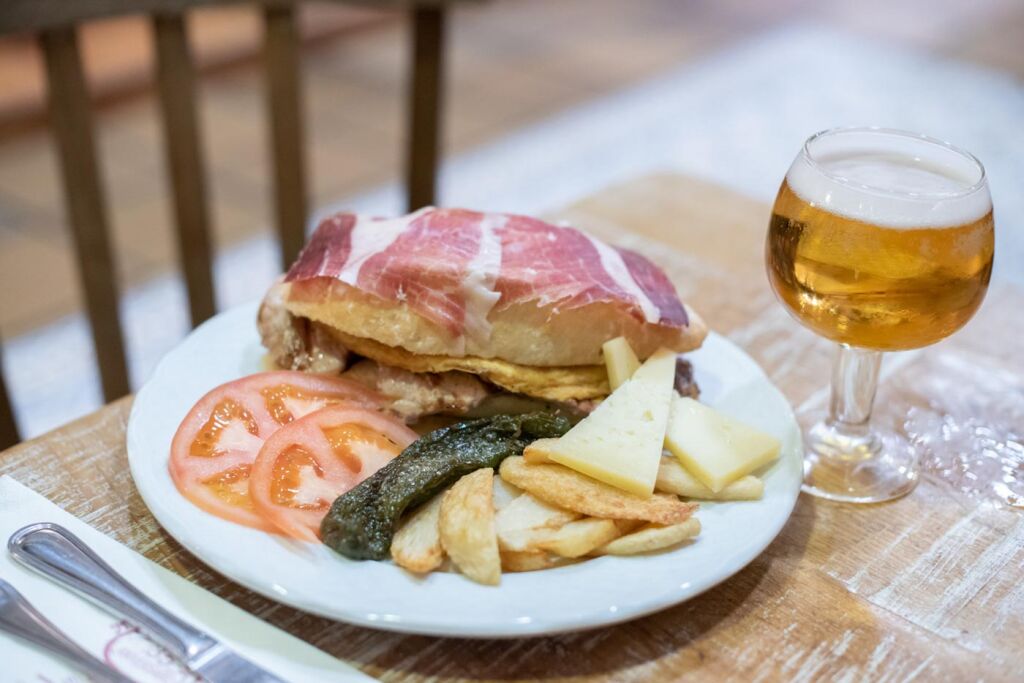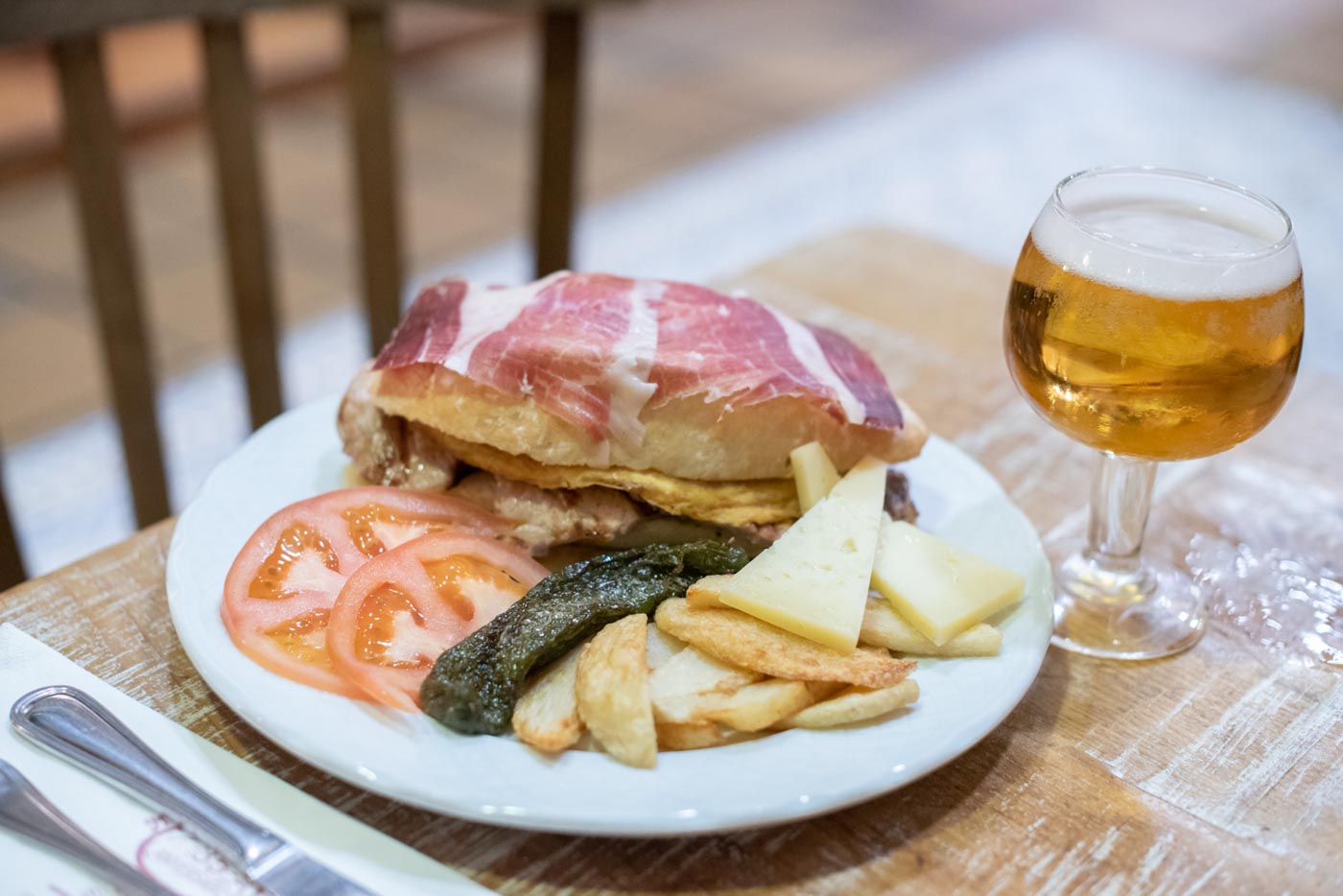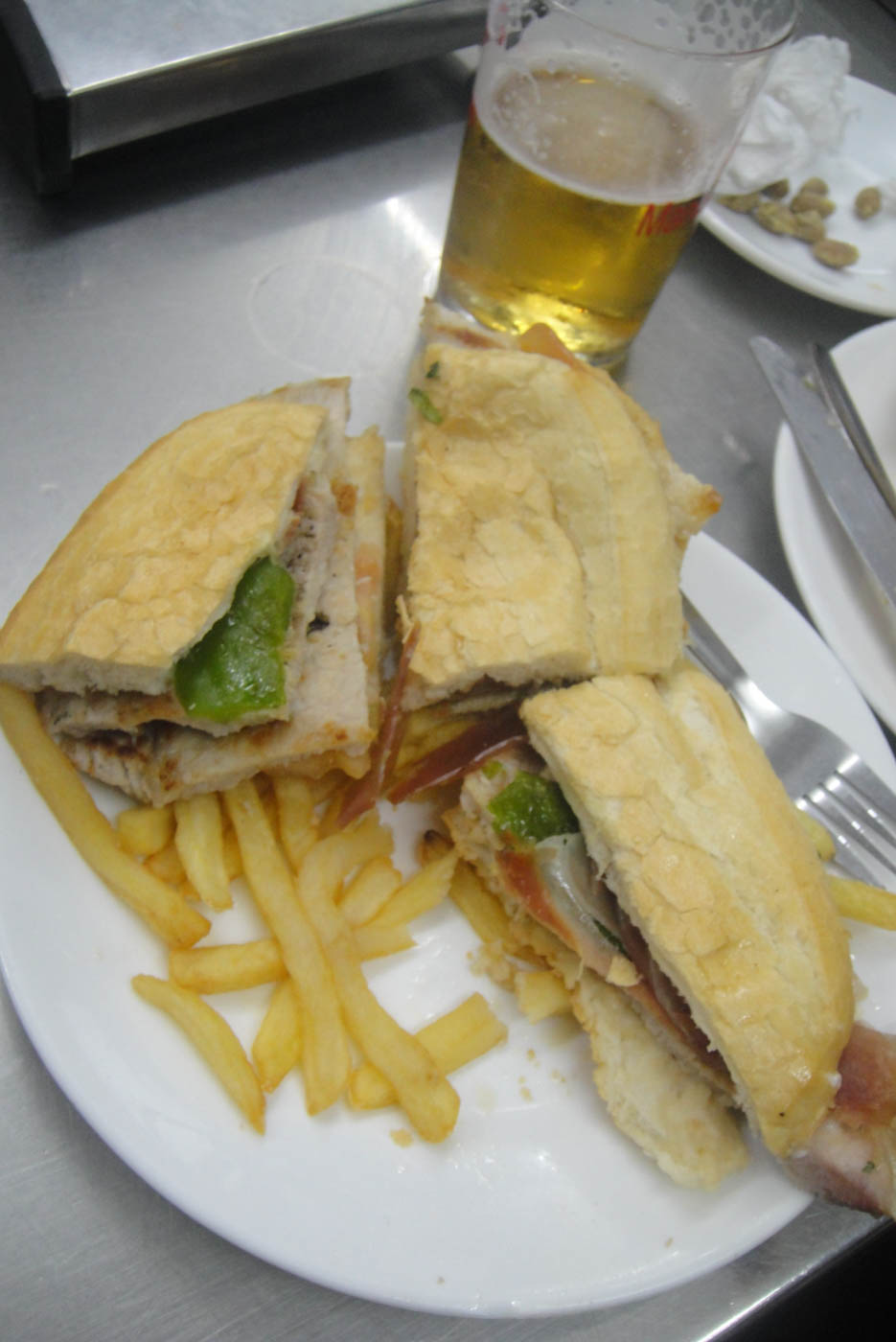Unless you’re familiar with Andalusian cuisine, you may not have heard much about the much-loved serranito, a popular sandwich hailing from Seville. It may not be as widely known as some of the other Spanish delights, many of which are featured on my Spain food tours, but it’s just as delectable!
What Is a Serranito?
Photo credit: Wikimedia Commons licensed under Attribution-ShareAlike 4.0 International
Typically served warm, serranitos are made by combining Andalusian staples, such as Iberian ham, pork loin, tomatoes, and green pepper, all stuffed inside fresh bread. Nevertheless, there are plenty of variations for those looking for something a little different.
Throughout this article, I’ll dive into the ins and outs of this tasty sandwich, ensuring you know how to find quality serranito and what to pair it with.
The Main Ingredients: A Breakdown
You’ll likely notice that the components of a serranito can vary depending on where you go, but a classic take on this sandwich will usually include the following ingredients:
- Pork loin or pork chops
- Thinly sliced Iberian ham or Serrano ham
- Sliced tomato
- Roasted or fried green peppers
- Breads like crusty viena andaluza baguettes or soft mollete flatbreads
- Olive oil
- Salt
- Alioli (garlic and olive oil)
As is the case with many other sandwich recipes, you’ll typically have the option to make substitutions or add unconventional extras. For instance, some establishments swap pork loins for chicken breast or include cheese and spicy mojo picón in their serranitos.
How It’s Made: Preparation and Elaboration
Photo credit: Wikimedia Commons licensed under Attribution-ShareAlike 3.0 Unported
It might seem like a simple sandwich, but there are numerous steps involved in crafting the perfect serranito.
You’ll first need to wash your green peppers and fry them whole in olive oil. Alternatively, you might prefer to roast them in the oven. Once cooked, leave them to rest and sprinkle a touch of salt on top before removing the seeds and stems.
In the meantime, rub your sliced pork loins with olive oil and salt and place them on a grill, cooking them on both sides until golden brown. At this point, you can start to slice your tomatoes.
When the pork loins are cooked, you’ll be ready to assemble your sandwich. First, you’ll spread the aioli on your bread. From here, simply add the pork loin, Iberian or Serrano ham, peppers, and tomatoes in any order you wish.
Why Locals Love It: The Serranito Experience
The serranito is treasured among locals in Seville for a plethora of reasons.
Most importantly, it tastes incredible! These sandwiches offer a diverse range of flavors and textures. From the rich, savory meats and warm bread to the zesty tomatoes and bittersweet peppers, a well-made serranito is a balanced and satisfying dish.
Not only is it delicious, but a serranito is among the most affordable food options in the city. Many eateries sell these sandwiches for around €10, with smaller sizes going for much less. If you’re looking for something that will keep you full for a great price, a serranito is tough to beat!
For locals, enjoying a serranito is also a cultural experience. In many instances, it’s a go-to dish for social outings, whether at a stylish tapas bar or casual bocadillo joint.
Accompaniments and Serving Suggestions
Although a traditional serranito is superb in its own right, choosing the right accompaniments is the key to taking your sandwich up a notch.
I love a serranito with a generous helping of aioli, but it also works well with just a dash of olive oil on both pieces of bread. Whenever I’m craving something with more of a kick, I opt for some mojo picón, a fiery sauce made from red peppers, red wine vinegar, and garlic.
In terms of side dishes, you can’t go wrong with patatas bravas, fries, or potato chips. Alternatively, some salty olives or fried peppers are ideal if you’d prefer something lighter.
For drinks, I suggest keeping it classic with a cold beer or a glass of refreshing tinto de verano.
How to Spot a Great Serranito
Photo credit: Wikimedia Commons licensed under Attribution-ShareAlike 3.0 Unported
A top-tier serrantino will have the following qualities:
- Fresh ingredients, such as crunchy bread with a soft interior, tender peppers, and juicy tomatoes
- Cooked to order rather than reheated
- Warm bread
- Moist pork instead of dry, overcooked alternatives
Where to Try a Serranito in Seville
Pretty much every second eatery in Seville features serranitos on the menu, but it’s especially popular in traditional sandwich shops, low-key bars, and relaxed restaurants. Smaller varieties are sometimes served as tapas dishes, but they’re also a reliable option for lunch or dinner.
You can secure a serranito in any corner of the city, but some neighborhoods are especially famed for their offerings. For example, Triana has a vibrant culinary scene, Alameda is a hub for cultural experiences, and the Old Town is packed with authentic establishments.
Tips and Tricks for Serranito Lovers
- If it’s your first time sampling a serranito, consider choosing a smaller, tapas-style serving.
- For a more flavorful experience, ask for extra sauce on the side.
- Avid cooks might prefer to prepare a serranito at home. In this case, purchasing quality ingredients is essential.
- To put together an authentic serrantino, check out a video with a step-by-step guide.
Nutritional Snapshot of the Serranito
Depending on your dietary needs, you may be eager to know some nutritional information about these mouthwatering sandwiches. Serranitos contain both nutritious and not-so-wholesome elements, but they’re relatively balanced options when consumed in moderation.
You’ll get a mix of protein, carbohydrates, and healthy fats from the pork loin, bread, and olive oil, respectively. Additionally, green peppers and tomatoes contain magnesium and potassium, along with vitamins A and C.
However, Serrano and Iberian hams are high in sodium, and if you choose to include cheese in your sandwich, this will add a significant amount of saturated fat to the dish.
Final Thoughts: Bite into Seville’s Sandwich Culture
Snacking on a serranito or two during your visit to the Andalusian capital. It’s the perfect dish for cultural-loving foodies, as it highlights the regional passion for simple meals made from fresh, flavorful ingredients.
Sources:
Eating Europe. (n.d.). Spain Food Tours. Eating Europe. Retrieved July 4, 2025, from https://www.eatingeurope.com/spain/












